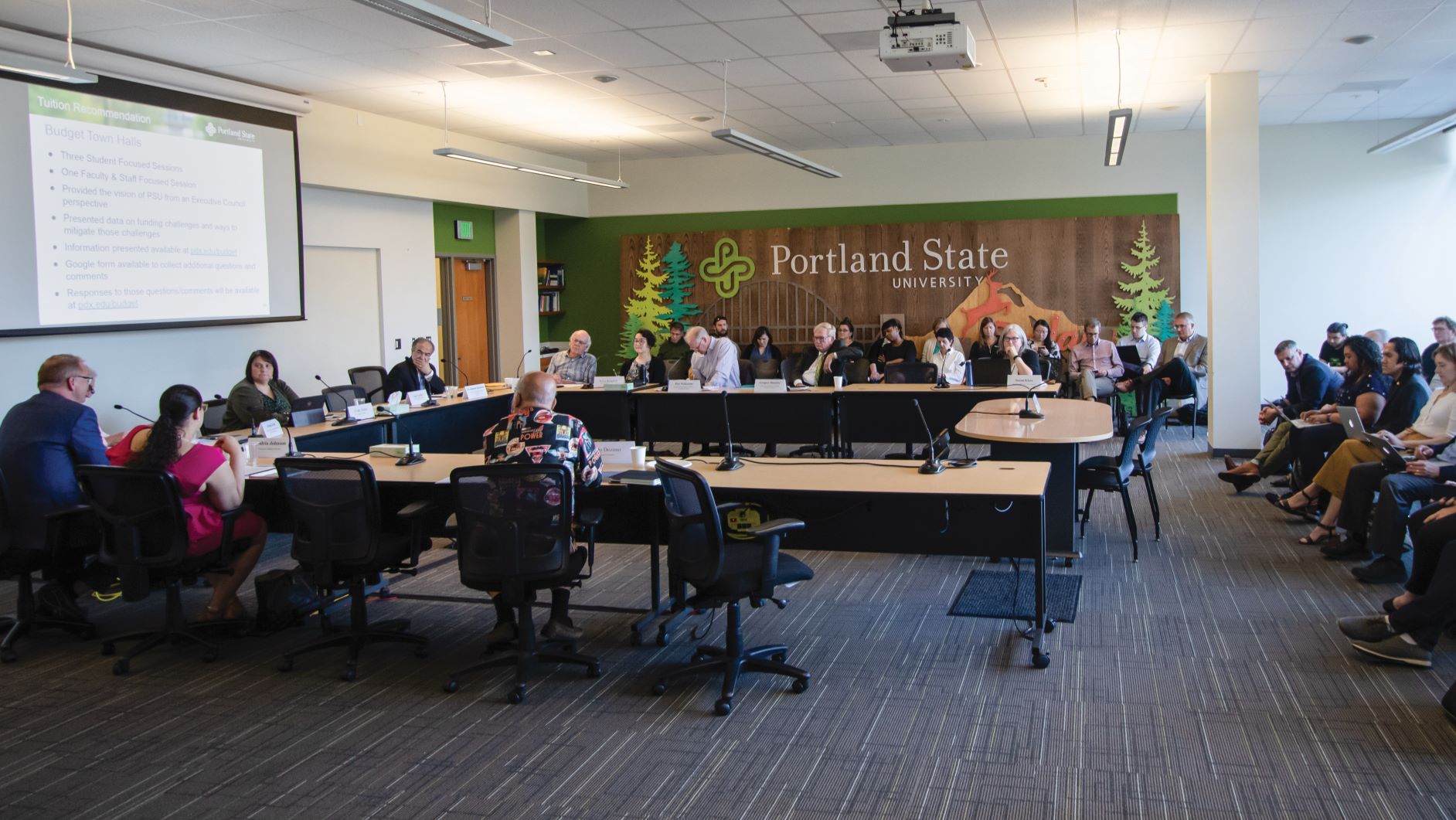The finance and administration committee voted to send a budget proposal—including an 11% increase in tuition for resident undergraduate students—to the Board of Trustees for consideration. The Board will vote on the budget on May 13.
Because the tuition increase is above 5%, the university will have to defend the Board’s decision before the Higher Education Coordinating Commission if they vote to approve this budget.
“Let me express the feeling that the goal [of the Board] is really not to increase tuition unless it’s absolutely necessary,” Portland State President Rahmat Shoureshi said.
Associated Students of PSU President Luis Balderas-Villagrana recommended to the Board a zero percent tuition increase for resident, non-resident and graduate students.
Balderas-Villagrana added, “As student body president, as somebody who does work with state legislators and over these past months has worked with the administration, I know that a zero percent tuition increase is not rational. I think we are in a tough time at the university, and I try to be hopeful but I am questioning whether the state will give us more money at this point.”
The 11% increase
For a zero percent increase—at the level of investment from the state—the university would have to find $21–23 million in operational cuts. At a 5% increase, the university would have to find $13–15 million in cuts.
Reynolds explained that the school looked at approximately $16 million in reductions in keeping with the 5% tuition increase benchmark.
“We rejected $6 million in cuts which were just too impactful on student support, timely graduation, academic quality and long-term fiscal stability,” Reynolds said.
“Examples would be not filling any of the tenure line positions…reducing the number of advisors that we just put in, not funding financial aid, reducing the amount remissions available,” Reynolds said.
The exact reduction in available remissions amounts an estimated 500–1,000 Pell grant-eligible Oregonians who would no longer be able to participate in those programs.
$16 million in cuts could also impact national accreditation, on-campus student employment opportunities and compliance and safety risk management, according to Reynold’s presentation.
With the remaining $10 million in cuts, the budget would require at least an 9–11% increase in tuition.
“The other thing we did—and this was a long deliberative meeting with the president and the executive committee—was to say these levels of reductions are so painful, even without that $6 million,” Reynolds said. “How do we try to protect or mitigate the impact on our academic affairs or our academic programs?”
Reynolds explained that an additional $500,000 had to be invested back into the office of academic affairs, which brought the tuition increase recommendation up to 11%.
“I would like to mention also that [the exact numbers] may change a bit after the state receives its revenue projections which are supposed to come on May 15, so some of the assumptions made in terms of how much the state is going to contribute may change,” Shoureshi said.
“Nobody wants to see that level of increase, but things are still fluid and we will do our best,” Shoureshi continued.
Strategic investments
There are also $1.5 million in strategic investments in the budget, including Information Technology educational services for student success, accommodation resources, financial aid staffing, campus public safety office, IT integrations and $200,000 in student-led investments.
“In accordance with [the strategic investment of $200,000], I will pass an executive order in the following two weeks creating a committee called the committee on student success that will review this investment and find the best way for students to be involved,” Balderas-Villagrana said.
The student-led investments, according to Reynolds, will be an avenue through which students can address the increasing demand to tackle issues like food insecurity and housing.
“I think this will be important when we talk to the HECC; if we don’t raise tuition at a higher level, we can’t fund these sorts of initiatives,” Reynolds said.
How PSU compares
Oregon State University, Eastern Oregon University and Western Oregon University are all proposing an undergraduate tuition increase lower than 5%.
When comparing undergraduate tuition for these universities against PSU, OSU tuition for undergraduate resident and non-resident tuition is higher. For EOU, tuition for both resident and non-resident undergraduates is lower than PSU.
For PSU, undergraduate resident tuition represents 43% of the gross tuition revenue.
Reynolds also said that, unless something significantly changes, it is likely that Oregon Institute of Technology, Southern Oregon University and University of Oregon will increase their tuition above 5%.
“Our colleagues don’t sit in the same place as us financially,” Reynolds said.
When looking at the estimated forecasts of state fund allocations for some other universities in the state, OIT would be receiving $54,594, OSU and SOU would be receiving around $25,000 and UO would be getting $20,112 per degree. PSU would be receiving around $16,979 per degree.
“We have one of the lowest tuition rates, we have mostly in-state students and we receive one of the lowest levels of funding from the state—we don’t have much of a choice,” Reynolds said.
Focus of state legislators in education
According to Kevin Neely, associate vice president of government relations, the focus of state legislators this session has been investments in K-12 education.
The House passed an education revenue package on April 29 that did not include higher education institutions. The package is expected to generate over $1 billion annually, according to Neely.
“More state funding is the only immediate solution to protect students and preserve academic excellence,” Neely said. “The university community needs to be united in its demands for additional state funding.”
Unlike previous years, ASPSU did not participate in lobbying at the Capitol for more state funds this year in an effort to get a zero percent tuition increase commitment from the university. However, nearly 40 PSU students did participate in lobbying for additional funding on PSU Day at the Capitol on April 16.
“Advocacy from students at the other six [public universities in Oregon] has been a critical component of the gains made to date,” Neely said. “Student lobbying is always critical to increased public university funding.”
When asked what the university is doing right now, Neely said the administration’s highest priority is budget advocacy.
“[We are] working with an alliance of stakeholders, including faculty unions, community colleges and university partners, we have met with nearly 50 legislators and work regularly with legislative leadership and Governor [Kate] Brown to increase investment,” Neely said.






